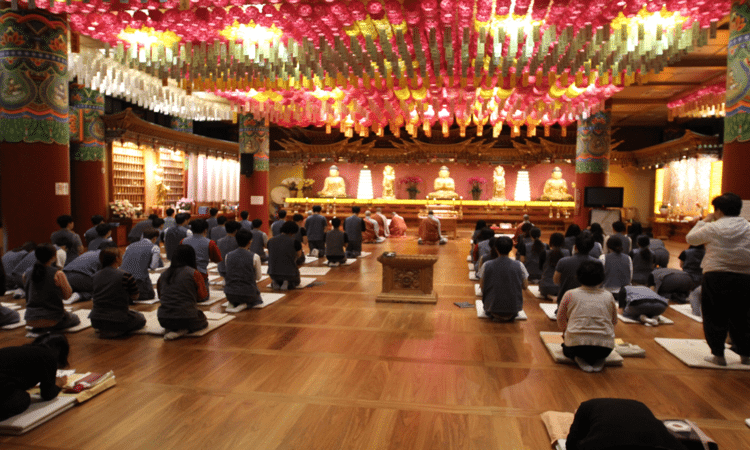Though nothing can replace the exciting hustle and bustle of urban life in South Korea, Temple Stays in South Korea offer a great way to escape the buzz of the busy city and surround yourself in nature.
Temple Stays are a unique cultural program offered in several Buddhist temples around South Korea. The program was designed to further educate visitors on the different aspects of Korean Buddhism.
During the Temple Stay program, visitors participate in the monastic Buddhist lifestyle for a short period of time – usually for 2 days and 1 night or just 1 day. Although Temple Stays are based on the teachings of Buddhism, Temple Stay programs are open to visitors from all backgrounds and religious beliefs. A typical run-down of the program includes participating in different Buddhist rituals which include Yebul (Ceremonial Service), Chamseon (Zen Meditation), Barugongyang (Monastic Meal) and Dado (Tea Ceremony).
At 10 Magazine, we’ve compiled a list of 10 Temple Stays around Korea (in no particular order).
1. International Seon Center Temple Stay | Yangcheon-gu, Seoul

The International Seon Center offers a global temple stay program to both local residents and foreign visitors. The Seon Center offers a variety of different Temple Stay programs that you can choose from. It also offers meditation classes, culture classes, and temple food lectures.
2. Myogaksa Temple Stay | Jongno-gu, Seoul

Located east of Naksan Mountain, Myogaksa Temple has been operating its Temple Stay programs since 2002. Myogaksa sees a growing number of foreign visitors and Temple Stay participants every year. Here, you can choose to stay for one day, two days and a night, or a specific program that lasts up to ten nights.
3. Jogyesa Temple Stay | Jongno-gu, Seoul

Located in the heart of Seoul, Jogyesa Temple offers the unique experience of a Temple Stay in the heart of the bustling city of Seoul. The Jogyesa Temple is one of the main temples in South Korea and the district head temple of the Jogye Order of Seoul. Jogyesa’s Dharma Hall hosts lectures and ceremonies all year long. Recently Jogyesa added the “temple life” program to its already existing temple stay programs. “Temple life” aims to teach its divese range of visitors about the spiritual value of Buddhism and offers an opportunity for participants to converse directly with monks living as Buddhist practitioners.
4. Beomeosa Temple Stay | Geumjeong-gu, Busan

Located at Geumjeongsan Mountain in Busan, Beomeosa Temple is one of the three major temples in the Yeongnam region. Visitors can choose two different types of temple stay programs at Beomeosa, such as the experience program and the relaxation program. The experience program focuses on Chamseon (Zen Meditation) and includes Yebul (Ceremonial Service) and Dado (Tea Ceremony). In the relaxation program, visitors can choose to either experience Chamseon (Zen Meditation) or register to have a conversation with a temple monk over a cup of tea.
5. Bulguksa Temple Stay | Gyeongju-si, Gyeongsangbuk-do

Listed as an UNESCO Heritage Site in 1995, Bulguksa Temple is home to many important cultural relics. The Temple Stay program offered at Bulguksa allows participants to learn about Buddhist culture during Korea’s Silla Kingdom. Here, you can participate in activities such as morning chanting, Chameseon (Zen Meditation), Dado (Tea Ceremony), and tours around the historical pagodas of the temple.
6. Haeinsa Temple Stay | Hapcheon-gun, Gyeongsangnam-do

Located in Gayasan Mountain, Haesina Temple is one of the most famous tourist attractions in Korea because of its collection of over 81,258 tablets containing Buddhist writings, known as the Palmandaejanggyeong (Tripitaka Koreana). Haeinsa offers a regular two-day one-night Temple Stay program, a no-limit period freestyle program, and a five-day and four-night training program during the summers.
7. Donghwasa Temple Stay | Dong-gu, Daegu

Located in Palgongsan Mountain, Donghwasa Temple is home to the Tongilyaksa Yeoraedaebul (Great Unification Buddha) that prays for the reunification of the nation. The temple also houses a plethora of other various cultural properties and important treasures of Buddhist culture. The Temple Stay at Donghwasa offers a two-day one-night program, three-day two-night program, and a more flexible Temple Life program in which participants can choose the number of hours they would like to stay at the temple. Donghwasa also offers group Temple Stay programs and a relaxation program.
8. Guinsa Temple Stay | Danyang-gun, Chungcheongbuk-do

Located below the Yeonhwabong Peak of Sobaeksan Mountain, Guinsa Temple is the headquarter for the Cheontae Order of Korean Buddhism. Guinsa has an impressive, 5-story main sanctuary as well as over 50 chambers within its grounds. Guinsa offers both the experiential program, where participants can stay at the temple for five-days and four-nights, or the relaxation program where participants don’t have to follow a disciplined program but instead learn about the basics of Buddhist ceremonies.
9. Lotus Lantern International Meditation Center | Ganghwa-gun, Incheon

Located on Gangwhado Island of Incheon, the Lotus Lantern International Meditation Center is a temple where both foreigners and Koreans can come together to practice meditation. Here, you can participate in the Gogyejong Temple Stay that offers either a standard two-day program, five-day program, or a freestyle program where you can stay as long as you like. The Lotus Lantern International also has foreign monks from Russia and Bangladesh who reside in the Center and can help foreign participants feel comfortable during their Temple Stay experience.
10. Yakchunsa Temple Stay | Seogwipo-si, Jeju-do

The Halla Mountain acts as the backdrop to the Yakchunsa Temple, which boasts the architectural style of the early Joseon Dynasty. With a total land area of 3,305 m², the Yakchunsa temple is one of the largest temples in the East. The springwater of Yakchunsa has legends of quenching thirst and curing illnesses to those who drink it, and is considered a treasured part of the community. The temple offers three different kinds of Temple Stay programs – a two-day one-night program, a one-day program which focuses on the daily life within the Korean temple, and a relaxation program.





